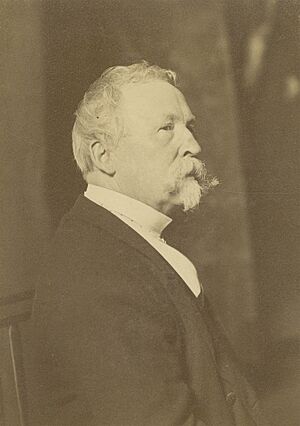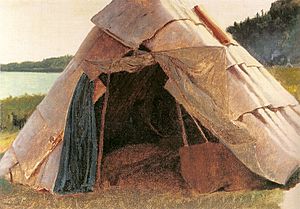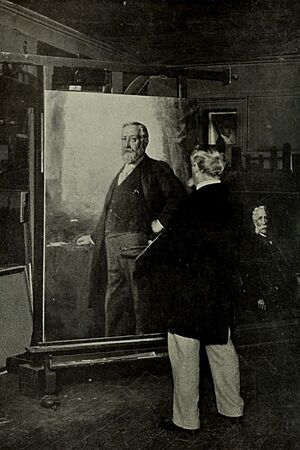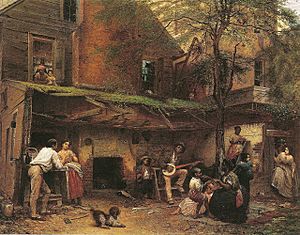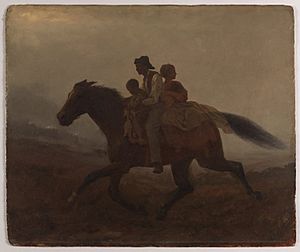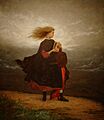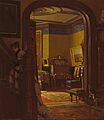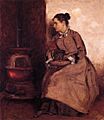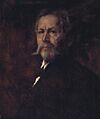Eastman Johnson facts for kids
Quick facts for kids
Eastman Johnson
|
|
|---|---|
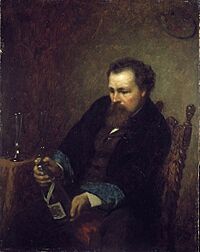
Self-portrait of Eastman Johnson, 1863
|
|
| Born | July 29, 1824 |
| Died | April 5, 1906 (aged 81) |
| Nationality | American |
| Known for | Painting |
Jonathan Eastman Johnson (born July 29, 1824 – died April 5, 1906) was an American painter. He helped start the Metropolitan Museum of Art in New York City, and his name is even carved at its entrance!
Eastman Johnson was famous for his genre paintings. These are artworks that show scenes from everyday life. He also painted many portraits of regular people and important Americans. Some of these famous people included Abraham Lincoln, Nathaniel Hawthorne, and Henry Wadsworth Longfellow. Later in his life, his paintings showed the influence of old Dutch masters. He studied their work in The Hague in the 1850s. People even called him The American Rembrandt back then.
Contents
Life of Eastman Johnson
Eastman Johnson was born in Lovell, Maine. He was one of eight children. His father, Philip Carrigan Johnson, owned several businesses. The family later lived in Fryeburg and Augusta. His father also worked as the Secretary of State for Maine for two years.
Career as an Artist
Eastman Johnson started his art career in 1840. He became an apprentice to a lithographer in Boston. A lithographer is someone who makes prints using a special stone or metal plate.
Later, his family moved to Washington, D.C. His father worked for the Navy Department there. Around age 20, Eastman also moved to Washington, D.C. He made crayon portraits to support himself. He even drew famous people like John Quincy Adams and Dolly Madison.
In 1849, Johnson traveled to Germany to study art. He joined the Kunstakademie Düsseldorf, a famous art school. Many American artists went there to learn. In 1851, he studied with Emanuel Gottlieb Leutze. Johnson then moved to The Hague to learn from 17th-century Dutch and Flemish artists. He finished his studies in Paris in 1855 before returning to the United States. He came back because his mother had passed away.
In 1856, he visited his sister in Superior, Wisconsin. There, he met Stephen Bonga, a guide who was both Ojibwe and African-American. Bonga helped Johnson visit the native Anishinaabe (Ojibwe) people. Johnson painted them often in 1857, showing them in everyday, relaxed poses.
By 1859, Johnson was back on the East Coast. He opened a studio in New York City. He became very well-known that year with his painting, Negro Life at the South (1859). This painting showed scenes from a backyard in Washington, D.C. It was sometimes called Old Kentucky Home. In 1859, Johnson became a member of the National Academy of Design.
In 1869, when he was 55, he got married to Elizabeth Buckley. They had one daughter, Ethel Eastman Johnson, in 1870. Eastman Johnson passed away in 1906 at age 81. He was buried in Green-Wood Cemetery in Brooklyn, New York.
Johnson's Painting Style
Eastman Johnson's paintings look very real. He focused on showing things exactly as they were. His early drawings were influenced by his lithography training. Later, his work showed ideas from 17th-century Dutch artists. He also learned from the French painter Jean-François Millet.
Johnson was very good at painting people as individuals, not just general types. An Ojibwe artist named Carl Gawboy has even said that the faces in Johnson's 1857 portraits of Ojibwe people look like people in the Ojibwe community today! Some of his paintings, like Ojibwe Wigwam at Grand Portage, are so realistic they almost look like photographs.
He also paid close attention to how light appeared in his paintings. For example, in Girl and Pets and The Boy Lincoln, he used a single light source. This was similar to the Dutch Masters he studied in the 1850s.
What Johnson Painted
Portraits
Johnson painted many different kinds of portraits. He painted rich and powerful people, like presidents and famous writers. But he was most known for painting everyday people in their daily lives. He sometimes painted the same subject more than once, changing small details or his style.
New England Life
Johnson became known as a genre painter because of his works about New England life. These paintings showed scenes like The Cranberry Harvest, Island of Nantucket, The Old Stagecoach, and Husking Bee, Island of Nantucket.
He often planned his paintings carefully in his studio. For example, for The Old Stagecoach, he used an old coach he found while hiking. He also asked local children to be models. Even though he planned it, the painting looked natural and peaceful.
Ojibwe People
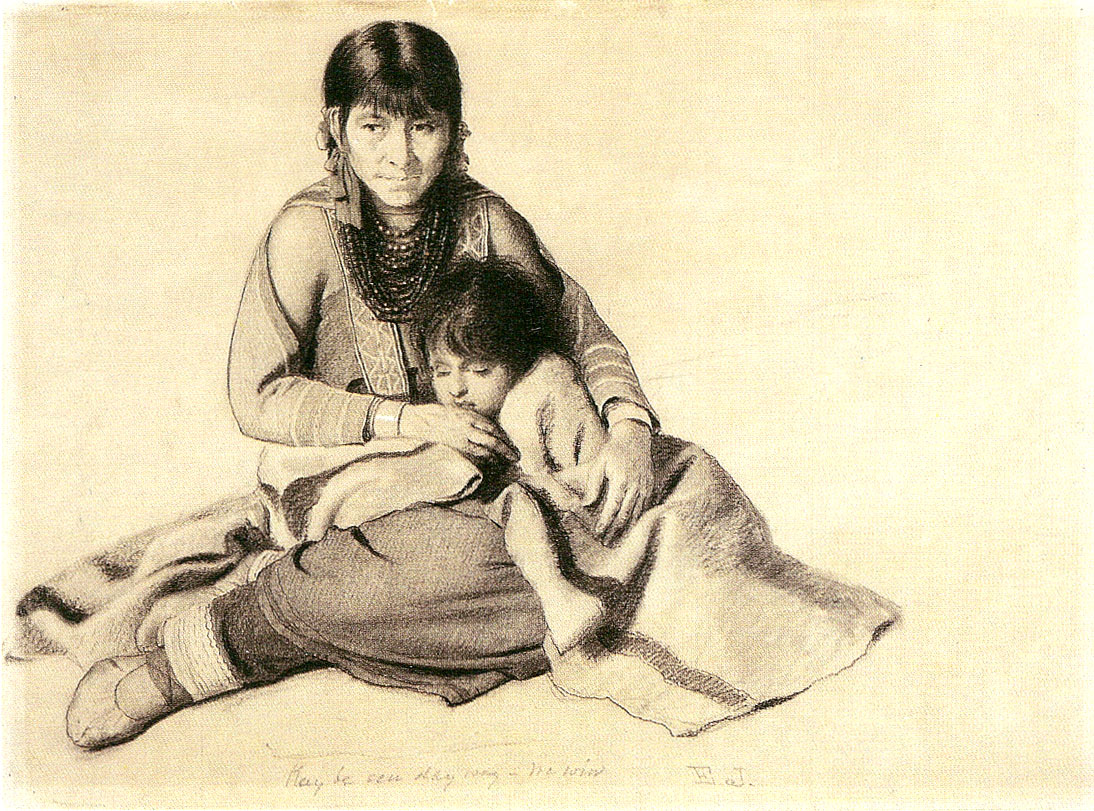 In 1856–1857, Johnson visited his sister in Superior, Wisconsin. He met Stephen Bonga, an interpreter who helped him meet Ojibwe people.
In 1856–1857, Johnson visited his sister in Superior, Wisconsin. He met Stephen Bonga, an interpreter who helped him meet Ojibwe people.
Johnson painted the Ojibwe people in a very personal and relaxed way. This was unusual for paintings of that time. He often included the names of the people in his artwork titles. He painted not just individual portraits, but also scenes of Ojibwe homes and daily activities.
Johnson left Wisconsin because of money problems. He moved to Cincinnati, Ohio, to earn money by painting portraits. He never painted the Ojibwe people again. His paintings and drawings of the Ojibwe were not sold during his lifetime. Today, they are kept by the St. Louis County Historical Society.
Slavery and Freedom
Negro Life at the South (1859) is considered one of Johnson's most important paintings. It shows a backyard scene of African-American life in Washington, D.C., just before the Civil War. The painting shows people doing everyday things behind a worn-down house. A nicer house is next door.
In the painting, you can see a young man and woman, a banjo player, and a woman dancing with a child. A young white woman, who is Johnson's sister, steps into this scene from the house next door. The people in the painting have different skin tones, showing the diversity within the African-American community. The painting shows both the challenges and the spirit of people living in difficult times.
Another important painting is A Ride for Liberty – The Fugitive Slaves (1862). This painting shows a family escaping to freedom at dawn during the Civil War. Johnson put the family right in the middle of the painting. This shows them taking charge of their own lives and seeking freedom. The painting captures the important moment when the issue of slavery became a major national topic. Johnson based this painting on what he saw during the Second Battle of Bull Run.
His painting, The Lord is My Shepherd (1863), shows an African-American man reading from the Bible. This painting was made soon after the Emancipation Proclamation, which declared many enslaved people free. Reading was seen as a very important step for freed people to improve their lives.
Gallery
-
Chester Alan Arthur, 1887.
-
Seth Low, c. 1890.
-
Benjamin Harrison, c. 1890–1900.
-
Stephen Grover Cleveland, c. 1890–1900.
-
Jay Gould, 1896.


